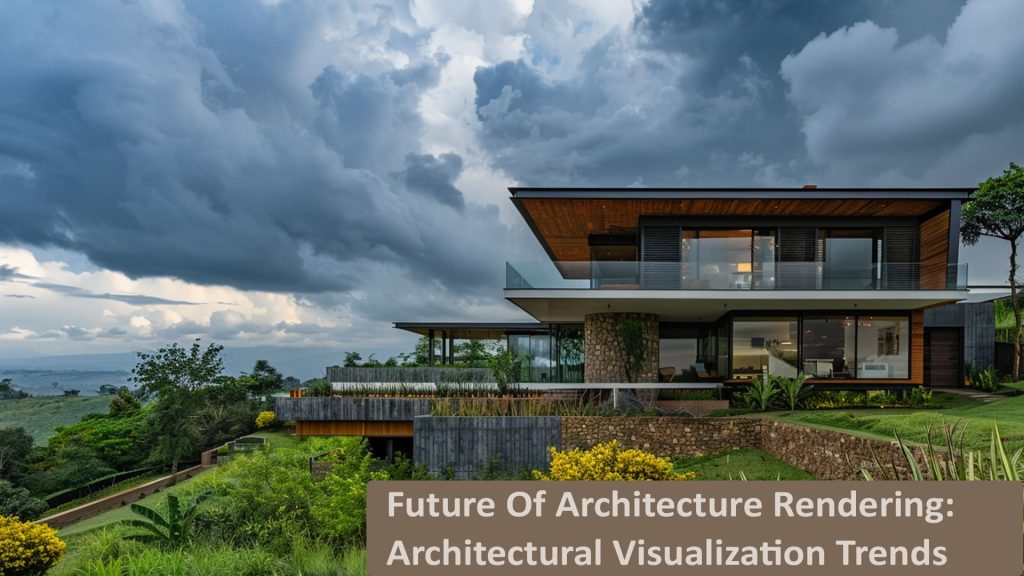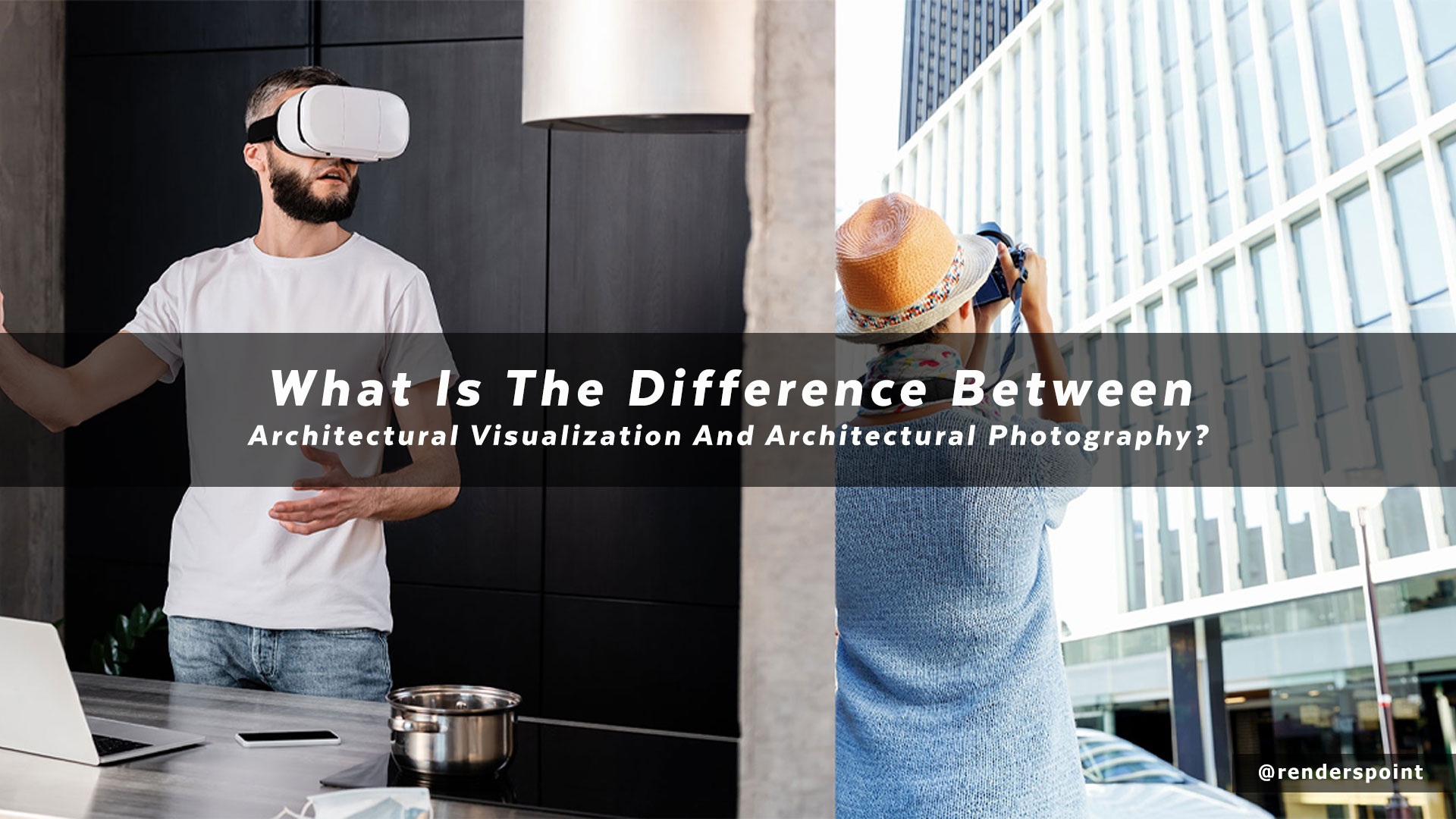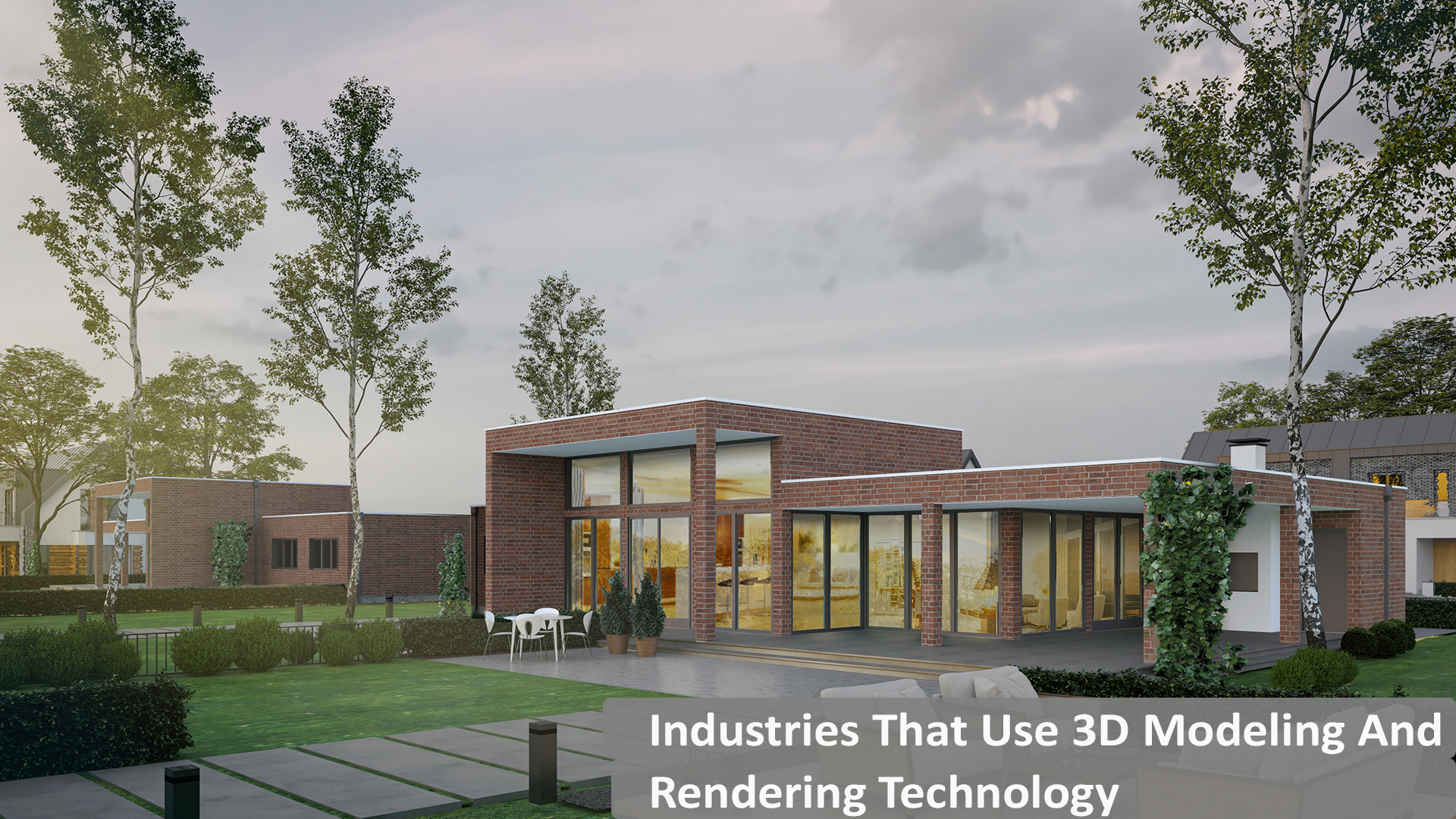What to expect in the future of architecture in world cities – The addition of architectural visualization and 3D rendering has taken the whole architectural design industry to a new level. The level that maintains a superior quality with the desired speed guarantee. Fantastic to hear, right? All thanks to the high-tech CGI tools, the architects will be able to accelerate the designing stage and implement their ideas during construction. However, the most advanced CGI tools have already influenced the whole architectural industry. The 3D visualization promises dramatic changes that will undoubtedly help the entire architectural industry attain new heights. So, there is no doubt in admitting that 3D visualizations can be a great helping hand in taking the architectural industry to reach new heights. But exactly it will be the future of architecture industry is hard to conclude as the innovation in technology and field will definitely take the whole industry to the next level. Let us get a clear vision over the trends & techniques in present & future of architecture industry.
How 3D Visualization Is The Future Of Architecture Designing
Most high-tech tools and technological advancements are oriented toward making the architectural designing and constructing field more effective and faster. The collaborative efforts, digital engineering, errors minimization, and rapid building element manufacturing is all possible now with the advanced 3D rendering and visualization services. Moreover, the project presentations and approvals will be much more accessible than ever. Now that we have gone through all the associations between both let us get familiar with what technologies are already shaping the 3D visualization’s future and how they will soon help change the architectural industry.
- Rapid prototyping will speed up the construction process – Rapid prototyping is strongly associated with 3D printing that allows printing everything a computer graphics artist can generate as a 3D model. Effective and quick prototyping is already being utilized in manufacturing and testing the construction products, and now gradually, it is making its way to building the houses. Therefore, the future of architecture 3D visualization will bring up rapid constructions.
- Augmented reality will transform the presentations into a new immersive experience – AR is the digital content’s overlay on the real-world environment. Currently, people use portable devices with AR applications, but the future will bring even more sophisticated tools. AR will help you in near future to showcase the project to the clients in a way that has never been done before. You may even be able to demonstrate the whole future building process live during presentations. A fantastic idea to execute the construction services!
- Virtual reality software will enable the design of projects in real-time – The virtual reality software in the architectural field generates a digital space for the designing processes in real-time. It also enables several specialists to work on a task simultaneously. Architects to build architectural 3D models and meet in VR altogether makes the whole process faster and easier. It is crucial for large-scale projects with stringent deadlines that require different specialist skills.
- Virtual Reality animation will immerse viewers inside the project – The animated 3D videos are primarily used to demonstrate a project strategy and ideas to the clients during the presentation. However, the day will come soon when Virtual reality 3D animation will replace all other video content. The 3D visualization future will bring architects improved walkthroughs and flythrough virtual reality animations. It will enable not only to examine the exterior but also explore the environment around it. In this manner, selecting the location for future construction will be no issue at all. Ith Virtual reality animations, the clients and viewers will also be immersed inside the project, where they will be able to analyze and explore the location devoid of the need to do it in reality. This will also allow the architects to work with overseas clients efficiently. A fantastic advancement from the future’s perspective in architecture!
- Mixed reality applications will prevent construction errors – Who doesn’t like a flawless output? Everybody does! The future of architecture 3D visualizations may include applications that combine AR and VR features. In short, the applications will allow the architects to visualize the materials overlaid in a real environment. Before moving further with the future conclusions of 3D rendering it is essential to know why 3D rendering and architectural visualizations are essential.
Why 3D renderings are essential?
- It displays and conveys better than a drawing.
- It resonates with young buyers.
- It saves time and money.
- It helps to streamline the buying process.
- It creates a genuine experience.
- It generates a great portfolio.
- It develops the online content.
- It helps prevent mistakes.
- It puts you ahead of your competitors.
The Future of Architecture Visualization
Earlier, pens and white papers were the only tools that architects used to convey their ideas, but things have changed drastically over time. The idea representation techniques have evolved to more convenient tools with technological advancements, including 3D design software and computer graphics. And after these, the 3D architectural visualization or rendering software came into the picture that continued to innovate the idea representation until the present. Earlier, the architects are not able to convey their ideas appropriately can do it all with the help of the 3D rendering technique without even saying a word. The artists can now portray their ideas by adding more innovative features to the images with the appropriate lighting and designs that make them look like they are from a fiction movie, painting, or a dream.
Several architectural visualizations have become more dynamic today. Even the artists have started adding pets, people and cars to the scene to add the scale that makes the scene look more realistic and alive. However, coming to the point of concluding that is the architectural visualization and 3D rendering the future of architecture industry? Things are still unsure of how much the technological advancements involving architectural visualization will be exactly five years later from now. But it goes without saying that we are going to witness a drastic change and enhancement in the field that perfectly imitates reality.
A Step Towards the Upcoming Architectural Visualization Trends
The world of architecture, engineering and construction is heading towards a major shift with the growth of rendering services in specific fields. “We are clearly on the edge of another revolution in the AEC industry” –Renderspoint. Architect rendering is nothing new. Since its inception in 1960, architect designers and 3d artists have worked together to bring excellent and swift results. History shows the continuous growth in how computer-generated imagery influenced decision-making, project perspective, customer experiences and workflows. Have a quick look into the rendering history:
- Many histories reassure us that the rendering became more sophisticated by introducing geometry-based architectural drawings in the 19th century.
- Architects were the only ones holding power to afford expensive rendering hardware and software unless technology emerged gradually.
- It then enhanced the overall content of different sectors with CGI and visuals.
CGI models collaborated with AI and VR (Virtual Reality) hold immense potential. It unleashes new possibilities to present original ideas with realistic visions. Renderspoint is putting its point of view with the given blog on what clients will expect from photorealistic visuals and virtual reality in the upcoming years.
Growing Expectations of Clients in Future Rendering
Technologies such as Artificial Intelligence, Augmented Reality and Virtual reality intensively impacted the photorealistic visualization process and CGI. In the next few years, rendering companies will undergo exciting changes.
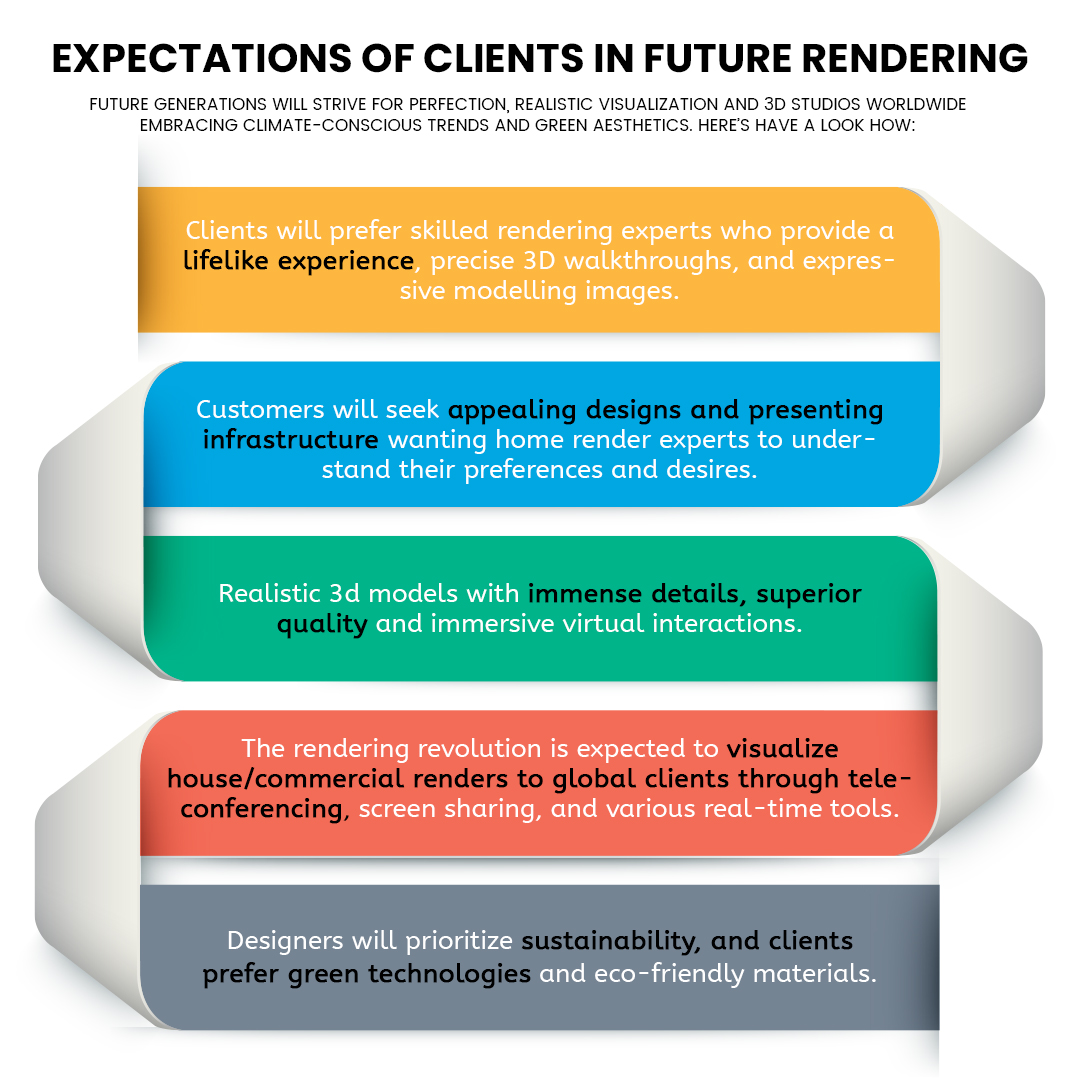
1. More Accuracy, Realistic and Immersive 3d modeling – In future, clients may not compromise on even minor errors in rendering 3d images for homes. The neck-to-neck competition among the best render companies presently made every artist bring perfection to the table. The future is going to beat up those talented artists more.
- They are likely to choose to render experts with qualified and exceptional skills.
- Clients will seek the feeling of a real living space while a 3d walkthrough and complete accuracy before the final build.
- They will undoubtedly expect three-dimensional modeling images to speak more than an architect could.
Renderspoint sees the future as more challenging and thrilling for rendering specialists with the stack of refining construction outputs.
2. Configuration, Customization, and Interactive elements in Render Images – When it comes to interior rendering, customers will look for more presenting design and infrastructure. The Home render experts need to follow the way to clients’ heart, how they think and what they want.
- Clients are expected to have more materials, colours, and furniture configurations.
- The best rendering companies must allow clients to participate entirely in the process, which will shift in the upcoming rendering trends.
Renderspoint sees it as the golden chance for interior and exterior renders to leave a remarkable impact on the clients and make transparent connections with them.
3. Surprising AR (Augmented Reality), VR and Rendering Trends in Future – 3d architecture rendering successful projects has set the expectation remarkably high. Clients will inevitably want engaging and detailed renders.
- Architects and designs can easily explain their perspective with AR apps and VR smart glasses. This is going to work like a magic world for prospects.
- The speed and efficiency of renderings will also increase. Henceforth, the rendering industry needs to set reliable time frames.
- 3d render interior design will provide a realistic understanding of the space. It will allow them to walk through space and interact with the design closely virtually.
Renderspoint perceives this as the significant growth achieved by rendering companies.
4. Expansion of Client Based Render Projects to Remotely Contracts – The introduction of AR, VR and smart glasses will take the future of house rendering and commercial visualization to the next level. The technology will help expand projects worldwide by remotely presenting their 3d render gallery and old projects.
- 360-degree views, panorama and aerial rendering will excite customers when builders approach clients through AI and VR.
- Even the reviews and customization will be made right before the clients through screen sharing, teleconferencing and various real-time tools.
Renderspoint knows that remote work will not only benefit render artists but also bring diversity to the architect’s designs.
5. Sustainable and Eco-friendly CGI Designs for A Better World – Designers realized the importance of using sustainable materials. Many render types do not show whether the architect’s design is eco-friendly and sustainable if the materials used support the environment.
- Clients are definitely going to ask for green technologies, energy-efficient features, and environmentally friendly materials.
- Future generations being more conscious of climate change will demand visualization studios in the UK and globally.
- The upcoming furniture trends, new interior materials, and décor fittings will support green beauty.
Renderspoint experts think the eco-friendlier materials will not only bring changes to the rendering processes but also make green the new norm.
Impact of Architectural Future Rendering Trends in Other Areas:
Photorealistic rendering will be the next industrial revolution, which will not only change architectural renderings. In the next section, you will briefly read how the following rendering trends may impact other areas of your life.
- Interesting Future of social media and Rendering – 3d rendering is not only the game for marketers and entrepreneurs. It is the age of socializing; everything is online. We are more curious about showing our best selves and ideal profiles with technology. Facebook, Instagram, Twitter, and WhatsApp users are likelier to want AR-supported photos, 3d profile backgrounds, Digital avatars, or character renders. Snapchat, Instagram, and many social media platforms have already introduced various 3d avatars. More is yet to come.
- Engagement of Digital influencers and Metaverse – CGI Charism generated with standard software is gaining enough attention to set the digital age to a new level. Guggimon (A Virtual influencing personality) is already winning the hearts of millions. YouTube may use Metaverse to generate powerful and impacting content. Your favourite influencers may be replaced with some digital entities. Besides, with the help of AR, VR and rendering techniques, you can even meet your friends in the different Metaverse.
- Switching from Human to 3D Artists, Reporters and Actors – Future of architecture holds the possibility to represent product advertisements with the supportive character render. You may see news reporters, dancers, singers and even actors crafted by some of the best render specialists near me. We are not scaring you; the next generations will experience the cusp of highly advanced render projects. And this will be the WIN-WIN for both the teams.
- Surprising Visualization in Gamification Rendering – Game lovers and clients expect an interactive user experience, as realistic as possible. To escape boredom, clients eagerly want a completely immersive gaming environment. So, 3d rendering services are expected to be integrated into mobile phones and gaming sectors to a huge course.
7+ Future Trends in Architecture Transforming Architectural Visualization Industry
Architectural visualization is on the cusp of a transformative era! Indeed, driven by advancements in technology and evolving industry demands. From AI-powered rendering to compact living spaces, several trends are shaping the future of architecture. Renderspoint brings you key futuristic trends that will revolutionize the field of architectural CGI and provide valuable insights into what lies ahead. Also, for a better understanding, we shall use a scenario:- An architect is tasked to design an apartment building. And, we’ll understand how these trends can enhance the design process and meet the expectations of potential residents.
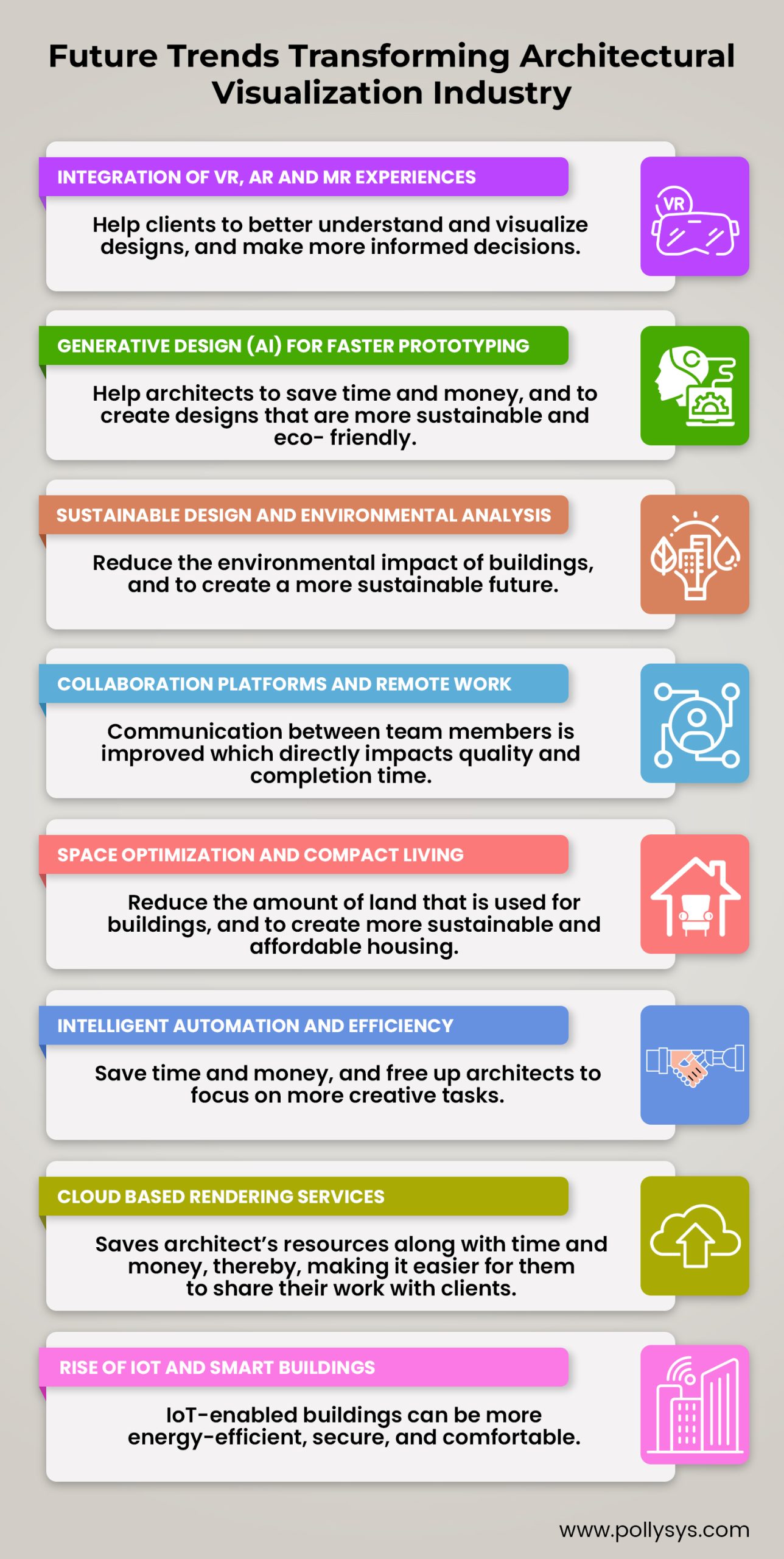
1. Integration of VR and AR Experiences:
The integration of virtual reality (VR) and augmented reality (AR) technologies brings CGI to a new level of engagement. VR allows users to explore and interact with virtual environments, while AR overlays digital information onto the real world. These technologies enhance design communication, facilitate on-site visualization, and offer unparalleled user experiences How? Have a look.
👉 VR/AR provides immersive experiences for potential buyers, aiding visualization.
👉 Identifies design flaws early, reducing construction costs.
👉 Enables virtual staging and customization, aiding decision-making.
👉 Facilitates real-time design modifications and approvals.
👉 Boosts marketing efforts with engaging visualizations.
👉 Streamlines construction planning through virtual walkthroughs.
👉 Improves overall efficiency and cost-effectiveness of the construction process.
Virtual reality (VR) and augmented reality (AR) would be especially helpful for clients who are unable to visit the site in person. AR could also be used to overlay the design on the real world, which would help clients to visualize how the building would fit into the existing environment.
2. Generative Design (AI) and Data-Driven Decision Making:
Generative design, empowered by AI algorithms, generates numerous design options based on specified parameters whatever they be. This trend, combined with the availability of big data, allows architects to make data-driven decisions, optimizing designs for sustainability, user preferences, and functional requirements.
🤔 How can AI help me (architects & designers) in designing 3D renders for my clients?
👉 AI-powered rendering automates tasks, saving time.
👉 It optimizes scene composition and settings for efficiency.
👉 AI improves realistic lighting simulations.
👉 AI denoising reduces rendering noise, speeding up output.
👉 Machine learning automates object recognition and material mapping.
👉 Quick design iteration aids in better decision-making.
👉 AI creates photorealistic renderings with realistic materials.
👉 It enhances the quality and visual impact of presentations.
👉 AI generates and evaluates design variations.
Generative design algorithms can generate multiple apartment layout options based on parameters such as unit sizes, number of rooms, and spatial relationships. Data-driven decision making empowers architects to analyze factors like natural lighting, views, and unit configurations, optimizing apartment layouts for functionality, efficiency, and resident satisfaction.
3. Sustainable Design and Environmental Analysis:
With an increasing focus on sustainability, architectural visualization incorporates tools for analysing energy efficiency, carbon footprint, and environmental impact. These tools enable architects to visualize and optimize designs for reduced energy consumption, better thermal performance, and minimized environmental footprint.
🤔 Why do architects need to understand this architecture future trend “Sustainable Design and Environmental Analysis”?
👉 Architects need to understand sustainable design and environmental analysis to address climate change, reduce environmental impact, and meet evolving regulatory requirements.
You can utilize sustainable design principles and conduct environmental analysis to enhance the apartment building’s energy efficiency and reduce its environmental impact. By incorporating features like passive solar design, efficient HVAC systems, and green materials, you can create apartments that are environmentally friendly and energy-efficient, attracting eco-conscious residents.
4. Collaboration Platforms and Remote Work:
Cloud-based collaboration platforms facilitate seamless communication and real-time collaboration among architects, designers, and stakeholders, regardless of their geographical locations. This trend supports remote work, streamlines design iterations, and fosters efficient teamwork.
Collaboration platforms facilitate effective communication between architects, engineers, builders, and clients throughout the design and construction process. Remote work capabilities enable seamless coordination, allowing stakeholders to contribute their insights and feedback, ensuring a collaborative approach to designing the apartment building.
5. Space Optimization and Compact Living:
As living spaces become smaller, 3D architectural visualization showcases innovative solutions for space optimization. Techniques such as 3D floor planning, virtual staging, and augmented reality help clients envision how compact areas can be utilized effectively, incorporating multi-functional design concepts, and maximizing every square inch.
Through 3D visualization, you can explore innovative design solutions like multifunctional furniture, efficient storage solutions, and clever space planning, creating comfortable living spaces within compact apartment units.
6. Intelligent Automation and Efficiency:
As already shared in #2 AI-powered automation streamlines repetitive tasks, freeing up architects’ time for more creative and complex endeavors. Tasks such as rendering, furniture layout generation, and project management can be automated, enhancing efficiency and enabling architects to focus on design innovation.
Time and money are important. Aren’t they? Yes they are. For everyone! You can use intelligent automation to automate tasks, such as 3D rendering and 3D Modeling. This would save you time, money, hassles and other resources. Plus, it’ll allow you to focus on more creative and strategic aspects of the design process. I could also use efficiency principles to streamline the design process and to ensure that the project is delivered on time and within budget.
7. Cloud Based Rendering Services:
Rendering technologies are becoming more efficient, saving time and reducing costs associated with design revisions and physical mock-ups. This is making 3D architectural visualization more accessible to a wider range of architects and clients. Rendering tools and platforms are becoming easier to use, making it easier for architects and designers to adopt and integrate them into their workflows. This is increasing the accessibility of 3D architectural visualization and making it a more viable option for a wider range of projects.
Using cloud-based 3D rendering services to render the design of the apartment building on cloud servers would save you time and money on hardware and software costs.
8. Rise of IOT and Smart Buildings
The incorporation of IoT in 3D architectural visualization brings a new level of interactivity and intelligence to the design process, fostering smarter and more sustainable building solutions. IoT enables architects to integrate smart sensors and devices into their designs, providing real-time data on factors like temperature, lighting, and occupancy. This data can be utilized to create more accurate and dynamic visualizations, allowing architects and clients to assess the impact of these variables on the design, optimize energy efficiency, and enhance the overall functionality of the space.
For example, an architect could use IoT to monitor the performance of a building’s HVAC system. If the system is not performing properly, the architect could be alerted to the problem so that it can be fixed.
Bottom Line:
In all the designing fields, the visualization process does not stop at all. Designing and generating a new dream or building everything starts with visualization. You dreamt it. That is why you have tried making it real, and that is where the visualization plays a crucial role. Moving to the answer to the question, if we talk about that in the future, we can say that it is not the future of architecture but the present. However, it is essential to note that further advancements and technological leads in the near future can take the whole scenario to the next level. Therefore the 3D visualizations and realistic views will never go out of style. Still, to get the desired output, you must choose a reliable and quality service provider that never hesitates to adopt the technological advancements and execute it all will require professional expertise.
The future of architecture will rotate with the integration of new technologies and design solutions. The advanced rendering tools will allow users to create more realistic and detailed projects. With AI in rendering, designers can represent a building’s appearance as practical and immersive as possible. Customers’ buying experience will change and polishes up, while architect designers might generate more powerful renders. Social media presence and rendering trends will also change with the effect of 3d renders. Collectively, these changes may impact both designers and clients. Renderspoint is a leading industry for generating quality renders that has a seasoned team of 3d designers with unparalleled skills.
- Our team is dedicated to follow futuristic trends.
- We encourage our clients to participate fully in the designing and rendering processes.
- We use Sustainable materials to make projects visually appealing and eco-friendly.
- We use advanced rendering technology to produce the best 360-degree views, 3d walkthroughs, external/ internal renders and more.
Grab your phone and ring the team on 020 8146 5629. Contact us by email to get high-quality and reasonable cost-rendering services online.

